Abstract
The surface electric charge of biomaterials plays a pivotal role in determining their bioactivity and biocompatibility, especially in orthopedic and dental applications. This review analyzes recent progress (2015–2024) in understanding how electric properties, particularly surface charge and zeta potential, modulate cellular adhesion, proliferation, and differentiation. Negatively charged surfaces (−20 to −30 mV) were consistently associated with enhanced osteoblast activity and calcium mineralization, while positively charged surfaces often induced pro-inflammatory responses. We explore theoretical models of the electric double layer (EDL), methods for quantifying surface charge, and strategies for modifying surface potential to enhance biological outcomes. A comparative analysis of materials—hydroxyapatite coatings, PCL scaffolds, titanium surfaces, and piezoceramics—is provided. Finally, we highlight knowledge gaps in mechanistic understanding and emphasize the need for standardized protocols in evaluating the electric properties of biomaterials.
1. Introduction
In recent years, there has been growing interest in developing biomaterials with enhanced biocompatibility and bioactivity [1,2,3]. Biomaterials play a critical role in medicine, particularly in orthopedics and dentistry, where they are used to replace or restore bone tissue. To ensure successful integration, implanted materials must meet high standards of biocompatibility and functional performance. One of the key factors influencing these properties is the electric charge on the implant surface [4,5,6]. Modulating the surface electric charge has been shown to significantly influence how biomaterials interact with biological systems. For example, Kumar et al. [7] demonstrated that electrically charging hydroxyapatite improves bone–implant integration by enhancing protein adsorption. Polak et al. [8] showed that charged polymer surfaces affect both cell adhesion and antibacterial behavior, depending on charge polarity and magnitude. Surface modification studies by Iwai R. [9] and Metwally S. [4] further confirmed that moderately negative surfaces promote osteoblast function, while excessive positive charge may induce inflammation. Highly relevant is the 2022 study by Mao et al. [10], which developed piezoelectric BaTiO3/β-TCP ceramics with tunable surface charges via polarization. They found that negatively charged surfaces (BTCP−) increased protein adsorption and Ca2+ influx, promoting BMSC adhesion and osteogenic differentiation. In contrast, positively charged surfaces (BTCP+) inhibited M1 macrophage charging, thus modulating the immune microenvironment to favor osteogenesis. Charged PVDF-based films also show promise. For example, ref. [11] found that the distribution of heterogeneous surface potentials in BTNF/P(VDF-TrFE) nanocomposites enhanced fibronectin fibrillogenesis and integrin clustering, leading to improved mechanotransduction and osteogenesis both in vitro and in vivo. While many studies confirm the osteogenic benefits of negatively charged surfaces, the effects on immunomodulation are less systematically explored. A 2024 study using planar microelectrodes on macrophage–MSC co-cultures demonstrated that negatively charged surfaces can steer macrophages toward an M2 phenotype via PI3K–Akt signaling, indirectly enhancing osteogenesis [12]. These findings underscore that surface charge is a tunable parameter that can either support or hinder biofunctionality, depending on its direction, stability, and physiological context [2,5].
In addition to surface charge [13], osteointegration is affected by other material properties such as chemical composition, mechanical strength, surface roughness, and wettability [4,14,15,16]. Elements like calcium and phosphorus play a vital role in bone mineralization, while high strength and elasticity provide durability under mechanical loads [17,18]. Rougher surfaces promote better cellular adhesion, increasing the contact area with bone tissue, and higher surface hydrophilicity improves cell attachment and distribution across the implant [4,19,20,21]. Surface electric charge has a significant effect on both the biocompatibility and the functional behavior of biomaterials [22,23,24]. Studies published between 2015 and 2024 have consistently demonstrated that electrically charged surfaces enhance bone tissue regeneration and promote favorable cell–material interactions [25,26]. For instance, Bodhak S. et al. [25] reported that charging hydroxyapatite creates a surface electric field that attracts calcium ions and improves osteointegration. Yamashita et al. [6] observed enhanced osteoblast proliferation and early matrix deposition on charged calcium phosphate ceramics. Similarly, experiments by Kumar D. [7] and Bandyopadhyay A. [13] showed that charged hydroxyapatite and ceramics improved both adhesion and differentiation of mesenchymal stem cells. Other studies confirmed that such effects persist over time and are particularly pronounced on surfaces with zeta potential in the −20 to −30 mV range [27,28]. These results collectively support the use of surface charging as a strategy to actively guide cell behavior and accelerate bone healing. For instance, hydroxyapatite coatings with induced charging on titanium substrates have been shown to enhance osteogenesis [29,30,31]. Investigating how surface charge influences cell adhesion, proliferation, and differentiation has become increasingly relevant in the development of novel biomaterials, including titanium implants, hydroxyapatite coatings, and polymer-based composites [32,33,34,35,36,37]. This review aims to consolidate current knowledge, highlight the mechanisms of surface charge interaction with biological systems, and compare quantitative findings from recent studies.
Numerous studies have demonstrated that surface electric charge plays a critical role in modulating cellular behavior [38]. Charged hydroxyapatite surfaces (−25 mV) were shown to accelerate in vivo bone regeneration within 14 days [39]. Modified titanium surfaces also promoted BMSC adhesion and osteogenic marker expression under similar charge conditions [31,40]. In collagen–CaCO3 composites, negative surface charge improved early cell attachment and collagen matrix deposition [41]. Together, these findings suggest that moderately negative surfaces (−20 to −30 mV) consistently support osteoinductive cellular responses. One of the most extensively explored aspects is cell adhesion on charged surfaces. For example, negatively charged surfaces have been shown to enhance osteoblast adhesion due to favorable electrostatic interactions with the negative cell surface potential [27]. Moreover, positively charged surfaces may activate immune cells and stimulate inflammatory cascades, potentially resulting in adverse effects such as osteonecrosis [9]. Zeta potential and the structure of the electrical double layer have emerged as essential concepts for understanding the mechanisms of cellular response to material surfaces [6,42,43].
Mechanistically, the impact of electric charge on biocompatibility is mediated through electrostatic interactions with cells, charging of surface-bound molecules, and alterations in surface energy [44]. These factors influence the adsorption of proteins and cells, thus modulating the overall biological activity of the material. Several studies have demonstrated that surface charge, along with topography, wettability, and chemical composition, significantly affects cellular behavior and may contribute to inflammatory reactions or bacterial colonization or, conversely, promote cell proliferation and differentiation [22,45,46,47]. Biological cells exhibit both an active transmembrane potential and a passive surface potential. The transmembrane potential, typically ranging from −90 mV to −10 mV, is maintained in living cells by ion gradients through the action of membrane pumps such as the Na+/K+-ATPase. In contrast, the passive surface potential is determined by the distribution of negatively charged lipids (e.g., phosphatidylserine) and membrane proteins and remains present even in dead cells [37,48,49,50,51]. The surface charge of a material is determined by its chemical composition, microstructure, surface topography, stiffness, and surface free energy [40,52,53,54]. However, despite substantial progress, the precise mechanisms by which surface charge influences cell behavior remain insufficiently understood, and significant gaps remain: (i) a lack of standardized protocols for measuring and reporting ζ-potential across studies, (ii) inconsistent reporting on the magnitude and stability of charge, and (iii) limited integration of electrochemical theory into experimental design [55].
Advancing our knowledge of electric charge and its role in biomaterial-tissue interactions will allow researchers to develop targeted strategies for tailoring implant surfaces to optimize their biological performance. This review presents the principal methods for manipulating and controlling the surface charge of biomaterials, highlights ongoing challenges, and outlines future directions in the field of electrically tuned surfaces for biomedical applications.
2. Formation and Measurement of Surface Electric Charge in Biomaterials
As biomaterials directly interact with tissues and biological fluids, the electric charge they acquire in such environments is of paramount importance. Proteins and cells typically exhibit a negative surface charge, dependent on membrane composition and physiological state [56]. The cell membrane consists of a lipid bilayer embedded with proteins, which together serve as both an insulating barrier and a diffusion regulator for ions such as K+, Na+, and Cl− (Figure 1) [37,49]. In living cells, active ion transport mechanisms generate a transmembrane potential (−90 to −10 mV), while the outer membrane surface bears a passive surface potential due to the net negative charge of lipid headgroups and associated proteins. Surface electric charge affects cellular behavior by modulating protein adsorption, especially adhesion-mediating proteins such as fibronectin and vitronectin. Negatively charged surfaces enhance the adsorption of divalent cations (e.g., Ca2+), which can facilitate the formation of integrin-mediated focal adhesions. These focal adhesions trigger intracellular signaling cascades (e.g., FAK and PI3K-Akt) that govern cytoskeletal organization, cell proliferation, and osteogenic differentiation.
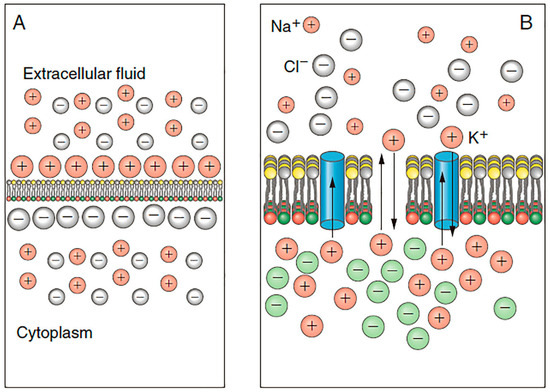
Figure 1.
Membrane potential formation scheme (A) Uneven ion distribution across the membrane. (B) Ion movement through channels (blue) is shown by arrows. Red, green, and gray circles represent Na⁺, K⁺, and Cl⁻, respectively. (Arrows indicate the direction of ion flow. The blue elements in the membrane represent ion channels.) [57].
To investigate surface charge, techniques like microelectrophoresis, capillary electrophoresis, and electrophoretic light scattering are employed to measure zeta potential. When a material is placed in biological fluid, a double electric layer (EDL) forms at the interface. The Helmholtz, Gouy-Chapman, and Stern models describe this structure, with the Stern model currently being the most accepted [58]. It posits that counterions form a compact layer (Helmholtz layer) near the surface and a diffused layer beyond it. The potential at the boundary of the diffused layer is the zeta potential (ζ), which is a key parameter in evaluating surface charge.
The study [28] provides a comprehensive overview of key methods used to measure the surface charge of biomaterials. These include Kelvin probe force microscopy (KPFM), electrostatic force microscopy (EFM), piezoresponse force microscopy (PFM), optical tweezers, thermally stimulated depolarization current (TSDC), surface plasmon resonance (SPR), and open-circuit potential (OCP) analysis.
Among these, the measurement of zeta potential in liquid environments is of particular importance for biomedical applications [59]. Since most biomaterials are intended for use in contact with physiological media and bodily fluids, assessing their surface charge in aqueous conditions provides the most relevant insights into their electrochemical interactions in vivo. All living cells are enclosed by a phospholipid bilayer containing embedded proteins, which together form a selective barrier that regulates the movement of ions such as potassium, sodium, chloride, and organic anions (e.g., amino acids). These ion gradients give rise to the transmembrane potential, typically ranging between +40 mV and −70 mV, depending on the cell type and physiological context [60].
The Stern model is currently the most widely accepted. It integrates elements of both earlier models by accounting for both specific adsorption of counterions and their thermal motion. In this model, counterions are distributed in two distinct regions: (1) the compact Helmholtz layer, where ions are closely adsorbed to the charged surface, and (2) the diffuse layer, which extends into the surrounding fluid. The potential at the boundary of the diffuse layer is referred to as the zeta potential (ζ), which is the key parameter used to quantify surface electric charge in a biologically relevant medium. Therefore, the electric double layer consists of the surface-defining ions and a surrounding cloud of counterions. EDL structure and zeta potential strongly influence cell and protein interactions with biomaterials.
3. Recent Advances in Surface Charge Engineering for Biomaterials
Recent studies [9] have shed light on the role of surface charge manipulation in enhancing the biological performance of biomaterials. For example, positively charged polyion complex nanoparticles with a surface potential of +19 mV have been shown to stimulate capillary-like network formation in adipose-derived stem cells (ADSCs). In contrast, surfaces with a negative charge around −28 mV demonstrated reduced differentiation and cellular organization. These findings underscore not only the significance of surface charge sign but also the importance of charge density distribution in tissue engineering applications [61].
In a recent study [27], researchers investigated the biological effects of chemically engineered carbon-fiber-reinforced PEEK (CFR-PEEK) surfaces modified with electronegative two-dimensional (2D) materials. The results indicated that such negatively charged coatings supported improved adhesion and proliferation of osteoblasts—cells essential for bone matrix production and mineralization. To evaluate biocompatibility, cytotoxicity tests were performed using mouse fibroblast L929 cells on extract media. Additionally, bone marrow-derived mesenchymal stem cells (BMSCs) were isolated from male Sprague Dawley rats to examine extracellular matrix (ECM) mineralization in vitro.
However, the study did not isolate the specific contribution of surface charge to cell behavior. Instead, greater emphasis was placed on analyzing the effects of surface porosity and mechanical characteristics of the electronegative 2D structures. No comparison was made with positively charged surfaces. Nonetheless, the study contributes meaningfully to the broader understanding of how charge-related surface modifications can enhance the bioactivity of implant materials.
Electrically charged hydroxyapatite (HAp) coatings on titanium substrates [48] have shown accelerated osteointegration. In vivo results revealed complete bone bridging between the implant and cortical bone within 14 days on negatively charged surfaces (−25 mV), whereas bone growth on non-charged controls was delayed until day 28. These findings suggest that negatively charged surfaces enhance Ca2+ and Mg2+ ion deposition, forming apatitic structures favorable for osteogenesis.
A similar trend was observed with electrospun poly(ε-caprolactone) (PCL) fibers, where zeta potentials between −30 and −45 mV enhanced calcium mineralization and cell adhesion in simulated body fluid [4]. The highest osteoblast proliferation rates (~60%) were recorded on rough, porous, and negatively charged surfaces (Figure 2, Figure 3 and Figure 4). This synergy suggests that electrostatic cues—modulated by surface architecture—play a central role in directing mineral deposition and tissue regeneration.
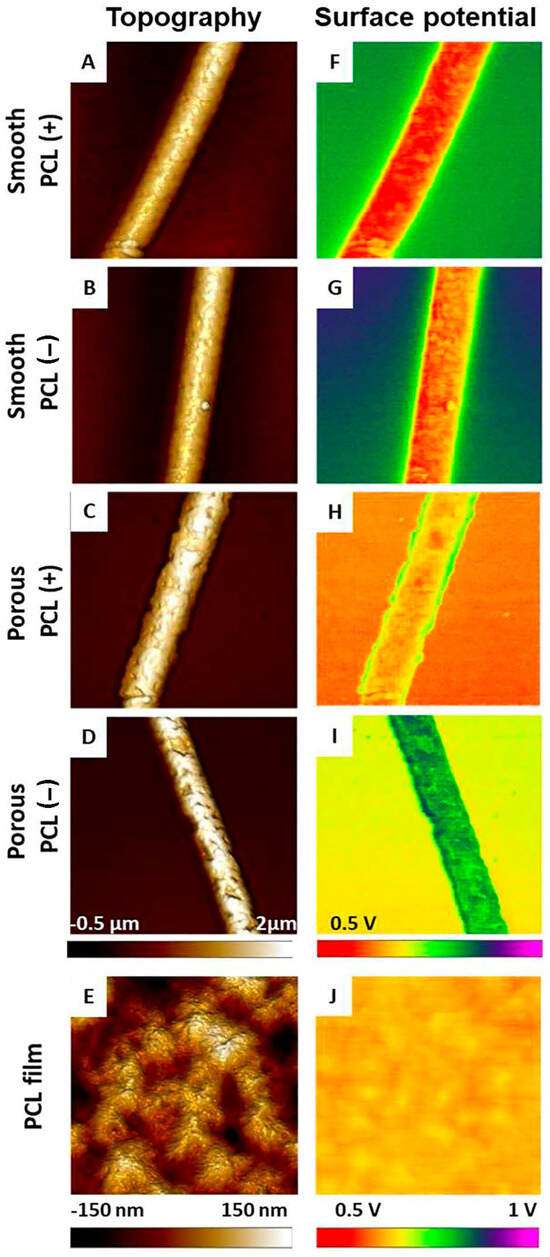
Figure 2.
KPFM results showing (A–E) surface topography and (F–J) map of the surface potential for the smooth PCL (+) and PCL (−), the porous PCL (+) and the PCL (−) fibers, and the PCL film. Warm colors (red/orange) indicate higher positive potential, cool colors (blue) represent lower/negative potential, and green denotes intermediate values. See scale bar for quantitative values (in mV) [4].
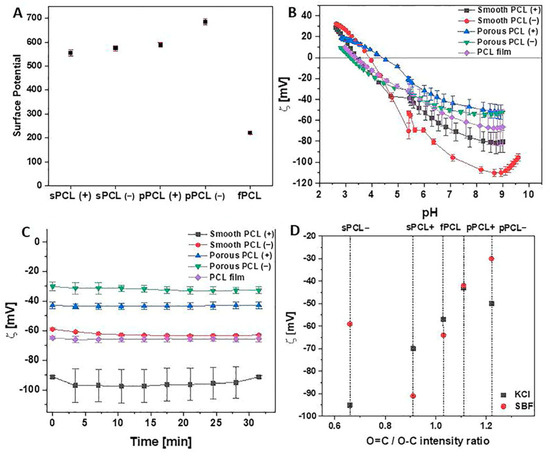
Figure 3.
KPFM results showing (A) the graph of the surface potential measured with the KPFM, (B) titration curves measured in the function of pH in KCL solution, (C) ζ in the function of time in the SBF solution in pH 7.4, and (D) ARXPS surface chemistry showing close to the linear relation of the O=C/O-C intensity ratio and the measured zeta potential [4].
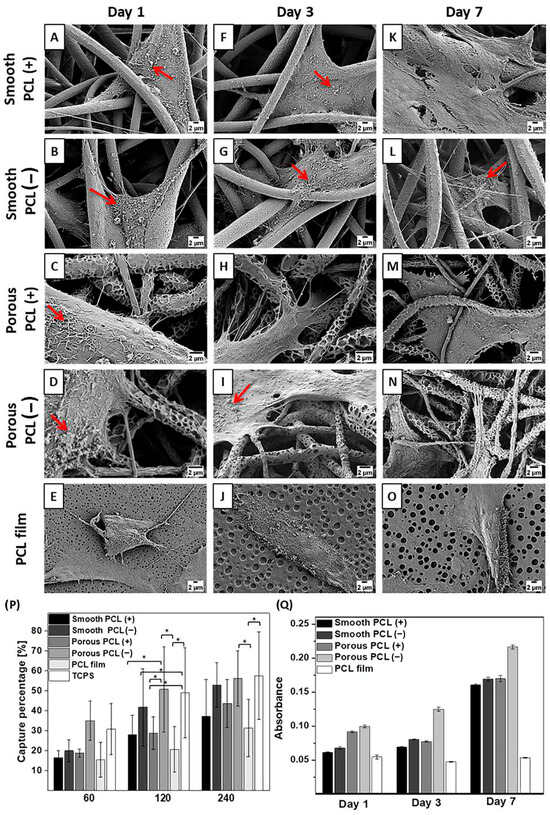
Figure 4.
SEM micrographs of cells growing on smooth, porous PCL fibers and after: (A–E) 1, (F–J) 3, and (K–O) 7 days of culture (red arrows indicate collagen fibrils), (P) graph of the capture percentage of the cells adhered after 1, 2, and 4 h, and (Q) Sirius Red absorbance indicating collagen formation after 1, 3, and 7 days of cell culture on the smooth PCL (+), PCL (−), the porous PCL (+), and the PCL (−) and the PCL film. Statistical significance was calculated with a one-way ANOVA followed by a post hoc Tukey test with a significance level of p < 0.05. In Panel (Q), the significant difference is presented among all the tested groups [4].
The results shown in Figure 4 provide a detailed temporal and morphological view of cell interaction with PCL-based surfaces. Panels A–E, F–J, and K–O show SEM micrographs of cell behavior after 1, 3, and 7 days of culture, respectively. On smooth PCL surfaces, fewer cells are seen spreading, with limited matrix deposition. In contrast, on porous negatively charged PCL fibers (PCL−), cells demonstrate increased adhesion, elongation along the fiber axis, and visible extracellular matrix (ECM) formation. The red arrows highlight well-defined collagen fibrils, particularly evident by day 7, suggesting active ECM remodeling on charged, porous substrates. Panel P quantitatively confirms early cell–material interactions, showing a significantly higher percentage of adhered cells on negatively charged porous PCL after just 1–4 h, compared to other tested surfaces. This indicates that surface charge and porosity together enhance initial adhesion dynamics.
Panel Q presents Sirius Red absorbance, a proxy for total collagen content, at 1, 3, and 7 days. Among all conditions, porous PCL (−) consistently leads to the highest collagen deposition over time. The statistical analysis (ANOVA followed by Tukey’s test, p < 0.05) confirms significant differences between groups, underlining the impact of surface electrostatic charge on ECM production. These findings support the hypothesis that moderately negative surface charge (−30 to −45 mV), combined with fiber porosity, optimally promotes osteoblast function and matrix synthesis.
In the study [39], the authors investigated the influence of surface topography and electric charge on the biological performance of titanium-based implants. Three types of nanostructured titania surfaces—nanowires (NW-Ti), nanonests (NN-Ti), and nanoflakes (NF-Ti)—were fabricated on titanium substrates using hydrothermal treatment (Figure 5). These surfaces exhibited different physicochemical properties while maintaining similar chemical composition. As shown in Figure 5, the SEM images demonstrate distinct surface morphologies produced by different hydrothermal treatments. The Ti-NW surface exhibits vertically aligned nanowires forming a high-aspect-ratio architecture, which may increase the available surface area for protein adsorption and cell anchorage. In contrast, the Ti-NN morphology features tangled, nest-like nanobundles with deep interstitial spaces, potentially influencing ion retention and cell infiltration. The Ti-NF sample shows overlapping nanoflakes that create a stratified structure resembling natural bone lamellae.
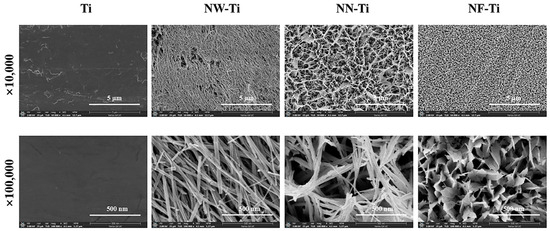
Figure 5.
Surface physicochemical properties of the smooth and hydrothermally treated Ti samples. Representative FE-SEM images showing surface morphologies of Ti, NW-Ti, NN-Ti, and NF-Ti [39].
Figure 6 confirms that all modified surfaces display significantly increased roughness compared to smooth Ti, with Ti-NF having the highest Ra values. BET analysis supports this, showing a 3–4-fold increase in specific surface area for Ti-NF and Ti-NN. GIXRD data indicate that phase composition remains largely unaltered after surface modification, ensuring biocompatibility is maintained. Wettability measurements reveal improved hydrophilicity, which is known to favor early protein adsorption and cell adhesion. Among the tested surfaces, the NW-Ti samples demonstrated the least negative zeta potential (approximately −25 mV at physiological pH 7.4), followed by NN-Ti (−16 mV), NF-Ti (−28 mV), and unmodified titanium (−37.5 mV) (Figure 6). This surface potential gradient influenced protein adsorption: a weaker negative charge enhanced the adsorption of fibronectin (Fn) and fibrinogen while reducing their denaturation and the exposure of pro-inflammatory epitopes. NW-Ti surfaces enhanced the availability of α5β1-integrin binding sites, thereby promoting cell adhesion and osteogenic differentiation. Moreover, NW-Ti surfaces facilitated macrophage charging toward an anti-inflammatory M2 phenotype, enhancing the immunomodulatory profile of the implant.
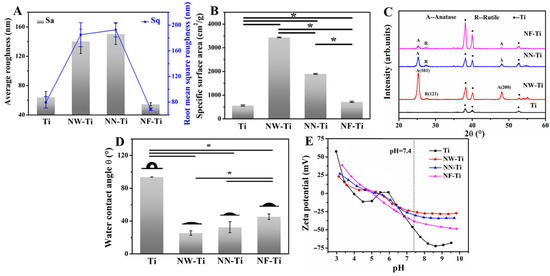
Figure 6.
Surface physicochemical properties of the smooth and hydrothermally treated Ti samples. (A) Surface roughness parameters of Sa and Sq of the samples obtained by AFM. (B) BET specific surface area of the samples deduced by using the BET equation. (C) GIXRD patterns of the prepared surfaces. (D) Surface wettability of the samples. (E) Zeta potential of the prepared surfaces as a function of pH. Asterisks (*) indicate statistically significant differences (* p < 0.05) compared to the control or between groups, as determined by [specific statistical test]. [39].
Zeta potential was measured using electrophoretic light scattering, and cellular responses were evaluated using ELISA, immunofluorescence, RT-qPCR, cytometry, microscopy, alkaline phosphatase (ALP) activity assays, mineralization staining, and in vivo osteointegration models. The study highlights the importance of not only topographical and chemical cues but also electric surface properties in directing cellular behavior and implant performance.
In a study [41], titanium surfaces were modified using collagen-based multilayer films incorporating cylindrical CaCO3 particles. This surface engineering strategy significantly improved the bioactivity of titanium implants. The researchers measured the zeta potential (ζ) of the coatings using a Zetasizer Nano ZS (Malvern Instruments, Malvern, UK) coupled with a ZEN 1020 dip cell. The zeta potential of the initial (PAA/Col)6 film was relatively low (−0.8 ± 0.5 mV). However, after deposition of CaCO3 nanoparticles, the potential decreased significantly to approximately −19 mV, confirming successful immobilization of the mineral particles onto the organic matrix.
This more negative surface potential was found to enhance calcium ion attraction and nucleation of apatite, thereby stimulating biomineralization. The authors also highlighted the role of topography and hydrophilicity in facilitating cell attachment. Microstructuring of the titanium surface increased surface roughness and reduced the water contact angle to below 7°, indicating high wettability.
Osteoblast viability, assessed using the MTT assay after 14 days of culture, showed a 1.4-fold increase on coated surfaces compared to the uncoated titanium control (Figure 7). These results suggest that the incorporation of negatively charged CaCO3 particles into collagen-based coatings not only improves cellular proliferation but also promotes favorable conditions for tissue regeneration by modifying the surface electrochemical profile of the implant.
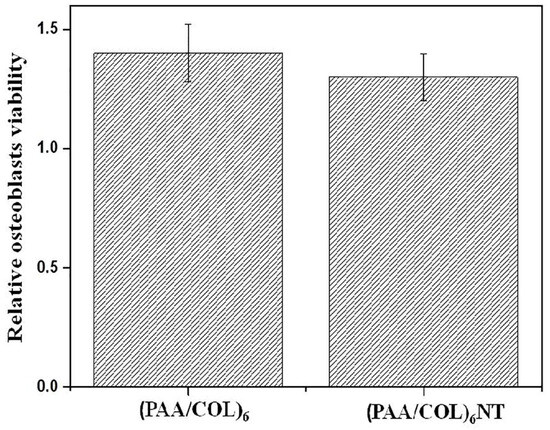
Figure 7.
Relative osteoblast viability in relation to the control (unmodified Ti disc) of the Ti discs coated with the (PAA/Col)6 or with the (PAA/Col)6NT film after 14 days of culture [41].
In a pivotal study [37], the authors investigated the regenerative potential of hydroxyapatite (HAp) plates with surface electrical treatment. The study demonstrated that electrically charged HAp significantly accelerates bone tissue regeneration by providing an electrostatically favorable environment for cellular adhesion, ion transport, and mineral deposition.
The best regenerative outcomes were observed on negatively charged HAp surfaces (N-surfaces), where calcium ion concentrations were highest. The results confirmed that not only the sign and magnitude of surface charge but also the direction and effective distance of impact critically influence bioactivity. It was shown that electrostatic fields generated by charged surfaces could affect ions and charged molecules at distances exceeding 0.7 mm.
Histology at 10 weeks showed continuous, directed bone formation from the margins of the defect toward the negatively charged HAp plate (Figure 8). In contrast, non-charged HAp plates showed sparse and fragmented bone formation that failed to bridge the defect fully. The positive side of the charged plate also supported bone growth, potentially by suppressing osteoclast activity, as suggested by the lower N.Oc/BS (number of osteoclasts per bone surface) ratios.
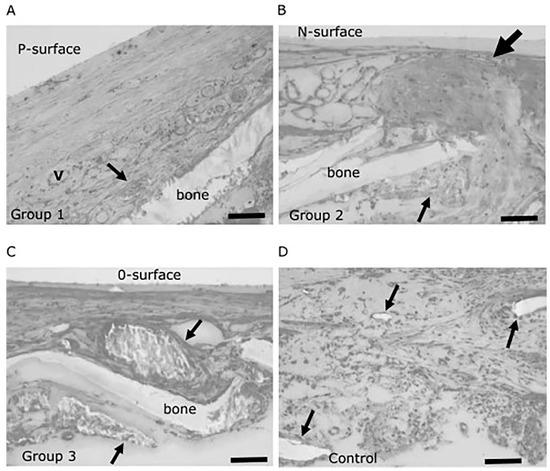
Figure 8.
Histology of the area with the implanted HAp plate after 10° weeks of surgery. Toluidine blue, scale bar: 0.1° mm. (A) Group 1; (B) group 2; (C) group 3; (D) control. In some samples from the groups that received charged HAp plates, the elongated bone from the margin of the bone hole has increased in thickness and joined together to complete bone bridging (A). Many newly formed blood vessels (V) and segmental bone growth formed around the bone debris (small arrows) are also found. The ossification center (large arrow) can be seen between the N-surface and elongating bone frontier (B). The thin elongated bone from the sample with a non-charged HAp plate meanders along the plate (C). In the control group, however, segmental bone formation around the bone debris is only observed in the thin fibrous scar tissue that fills the bone defect (D) [62].
Histological evaluation of bone defects at 6 and 10 weeks post-implantation demonstrated marked differences in the extent of new bone bridging (bridging length, BL) between experimental groups. Implants with electrically charged hydroxyapatite (HAp) surfaces—specifically groups 1 and 2—exhibited significantly longer BL compared to both the non-charged group (group 3) and the untreated control (Figure 9). The most pronounced bridging was observed in group 2, which featured a negatively charged HAp surface, suggesting enhanced osteoconductivity under these conditions.
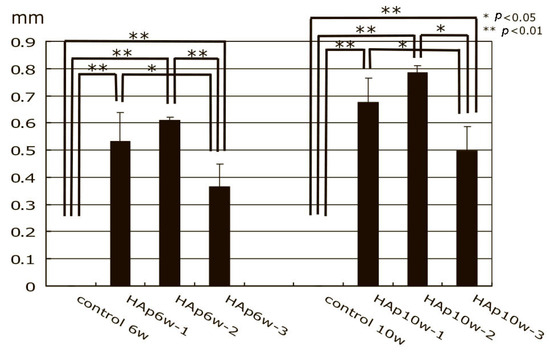
Figure 9.
BV of newly formed bone measured with the nondemineralized sections stained with toluidine blue (mean and SD) [62].
In contrast, group 3, which used non-charged plates, showed delayed and incomplete bone bridge formation. These findings indicate that the degree of bone regeneration strongly correlates with the surface charge state of the implant material. Electrostatic surface modification appears to stimulate key biological processes such as calcification and tissue formation by creating a favorable electromagnetic environment for cellular adhesion, growth, and differentiation. The surface electrical properties of implants are thus not merely physicochemical attributes but functional determinants of biocompatibility and regenerative performance. Controlling surface charge enables the fabrication of materials that not only enhance tissue integration but also reduce the risk of inflammation and implant failure. Continued research in this field is essential to optimize these electroactive surfaces and advance the development of safer and more effective biomaterials for clinical use.
Surface electric charge is a key parameter governing the interface between biomaterials and living tissues. It significantly affects cell adhesion, proliferation, and lineage-specific differentiation—all of which are critical for achieving successful and timely osseointegration. In the study [63], it was demonstrated that electrostatic forces alone can effectively drive cellular adhesion, even on topographically smooth surfaces. This challenges the conventional understanding that micro- or nanoscale roughness is a prerequisite for effective cell immobilization on biomaterials.
To test this phenomenon, the researchers exposed optically flat glass substrates—having a surface roughness of approximately 1.23 ± 0.59 nm—to ultraviolet (UV) irradiation. Following this treatment, Saccharomyces cerevisiae yeast cells were successfully immobilized on the irradiated surfaces. To assess changes in the surface’s electrostatic properties, the work function (φ) of the substrates was measured before and after UV exposure using photoelectron emission spectroscopy in a high-vacuum environment. Photon energies in the range of 3 to 6 eV were applied, and the work function was defined as the minimum energy required to release an electron from the material’s surface.
An increase in the work function was observed after UV treatment, indicating a rise in surface negativity. This enhanced negative charge promoted the adhesion of yeast cells, confirming that electrostatic attraction alone—independent of surface roughness or chemistry—can mediate effective biological integration.
These findings reinforce the concept that electrical surface potential is a fundamental parameter in cell–material interactions and can be strategically tuned to optimize biointerface performance.
The significance of investigating surface electrostatic potential in bone implant coatings stems from the fact that virtually all cell membranes—particularly those of bone-related cells—carry an intrinsic surface electric potential. This passive surface charge arises mainly from negatively charged phospholipids and membrane proteins and persists even after cell death. In contrast, the transmembrane potential is an active, energy-dependent voltage across the membrane generated by ion pumps such as the Na+/K+-ATPase. This action potential is critical for cellular function and signaling but collapses when the cell dies. Tofail [64] emphasized that bone formation is often more pronounced near negatively charged surfaces, whereas regions of positive charge may induce adverse effects such as osteonecrosis. Their experiments revealed that osteoclasts tend to migrate toward positively charged electrodes, whereas osteoblasts—the primary drivers of bone regeneration—are preferentially attracted to negative ones. This evidence supports the need for implant surfaces to maintain a stable negative surface potential to promote regenerative responses and reduce microbial colonization or inflammation. A net uncompensated negative surface charge may help restore physiological ion balances in adjacent tissues and improve implant integration.
Moreover, the compatibility of biomaterials with biological systems—referred to as bioelectrical compatibility—is increasingly recognized as a critical design parameter. Bioelectrical compatibility describes the ability of a biomaterial’s surface to interact favorably with the electrostatic properties of biological systems—primarily the net surface potential of cell membranes and the surrounding ionic microenvironment—without disturbing the physiological electrochemical balance or interfering with essential signaling pathways. A bioelectrically compatible surface typically promotes beneficial cellular behaviors such as adhesion, proliferation, and differentiation, while minimizing adverse responses such as inflammation or cytotoxicity. Understanding the complex interplay between electric charge, protein adsorption, and cell attachment is essential for developing the next generation of high-performance medical implants. As shown [16], both the surface zeta potential and nanoscale roughness of calcium phosphate substrates significantly influence the osteogenic differentiation of stromal cells. This dual dependency underscores the importance of integrating electrochemical and topographical optimization into implant surface design.
One study [36] offered a conceptual model of cell interaction with positively charged piezoceramic surfaces (Figure 10). Visualizations indicated high levels of cell adhesion and spreading on these modified samples. A conceptual model of cell interaction with positively charged biomaterial surfaces was proposed in the study by [36]. The scheme illustrates strong adhesion of cells to piezoceramic samples bearing a net positive charge. Biological assays involving cytoskeletal staining confirmed that cells cultured on these positively charged surfaces exhibited the greatest degree of spreading. Importantly, heterogeneity in charge density across the surface resulted in non-uniform cell distribution, suggesting that spatial variations in surface potential may influence cellular behavior at the microscale.
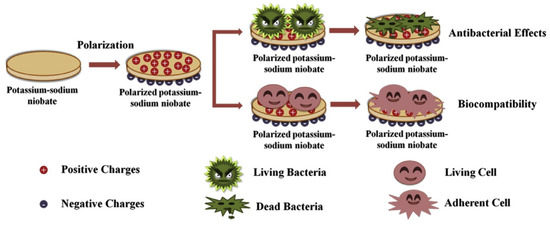
Figure 10.
Scheme of interaction of cells with a biomaterial with a positively charged surface [36].
Among the tested materials, samples with the highest density of positive charges—particularly those based on 80KNN—exhibited both excellent cytocompatibility and the strongest antibacterial activity (Figure 11). The underlying mechanism was attributed to the interaction of the positively charged piezoelectric surface with the negatively charged outer surface of bacterial membranes, triggering intracellular generation of reactive oxygen species (ROS). This ROS production disrupted membrane integrity and led to bacterial death. While ROS at physiological levels serve as regulatory signaling molecules, their accumulation becomes cytotoxic, which can be leveraged for antimicrobial purposes.
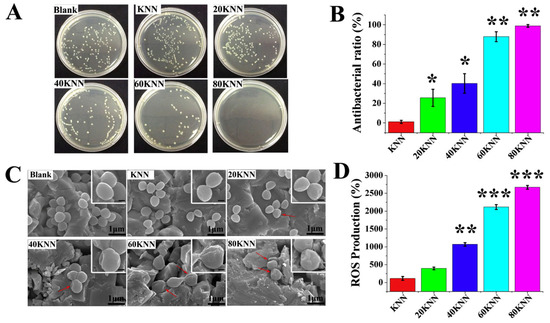
Figure 11.
(A) Representative images of S. aureus (1 × 106 CFU/mL) after coculturing with KNN, 20KNN, 40KNN, 60KNN, and 80KNN, respectively. It showed that the number of bacteria decreased with the increase in piezoelectric constants, and the number of bacteria on 80KNN was the least. (B) Antibacterial ratio of S. aureus (1 × 106 CFU/mL) re-cultured on agar after dissociation from the various surfaces. It also presented that the antibacterial ratios increased with the increase in piezoelectric constants, and the antibacterial ratio of 80KNN was almost 100%. (C) Surface morphology of the bacteria on the material surface by SEM. It showed that the number of bacteria decreased with the increase in piezoelectric constants, and the bacterial outer surface membranes were shrunken on the KNN materials (marked by red arrows). (D) ROS production measurement by the DCFH-DA method. Data showed the ROS production increased with the increase in piezoelectric constants, and the generation of ROS inside bacteria on the surface of 80KNN was the highest. The scale bar of the enlarged view is 200 nm. The data were shown as the means ± standard deviation (n = 4). * p < 0.05, ** p < 0.01, and *** p < 0.001 compared with KNN [36].
Cell proliferation studies revealed that materials with high positive charge promoted greater adhesion, yet the increase in viable cell numbers compared to the control was modest (Figure 12). This suggests that while initial attachment is enhanced through electrostatic interactions at the cell–material interface, it does not necessarily translate into accelerated proliferation. As is well known, the outer surfaces of both mammalian connective tissue cells and microbes tend to carry a net negative charge, supporting strong initial attraction to positively charged substrates. The authors also reported enhanced adsorption of proteins on positively charged materials. This indirectly facilitates cell adhesion by improving the availability of surface-bound ligands. In contrast, negatively charged materials tend to favor adsorption of divalent cations, such as Ca2+, which in turn promotes the formation of bone-like apatite layers and enhances both protein attachment and subsequent cell integration.
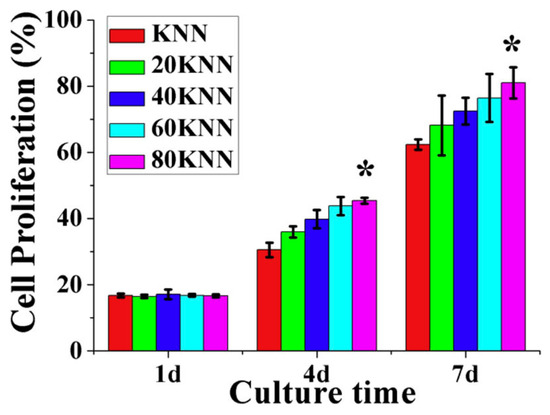
Figure 12.
Cell proliferation (CCK-8 assay) of rBMSCs (1 × 104 cells/mL) after cultivation with the KNN materials for 1 d, 4 d, and 7 d, respectively. It showed that these materials had good biocompatibilities compared with KNN. The data were shown as the means ± standard deviation (n = 4). * p < 0.05 compared with KNN [36].
Taken together, these findings highlight that the biological response to biomaterials is determined by multiple parameters: the sign, magnitude, density, and spatial distribution of surface charge. Tailoring these factors allows for controlled modulation of cellular adhesion, collagen mineralization, and tissue regeneration outcomes.
The comparative analysis of the data presented in Table 1 highlights a consistent and biologically meaningful relationship between surface electric potential and the functional behavior of cells in contact with implant materials. Across a range of compositions and surface modifications, negatively charged surfaces—with zeta potentials typically ranging from −20 to −45 mV—were repeatedly associated with enhanced osteoblast adhesion, proliferation, and mineralization. These effects were observed for diverse systems, including polymeric scaffolds, ceramics, and metallic implants, indicating the universality of electrostatic mechanisms in cell–material interactions. Conversely, highly positive surface charges demonstrated potential in antimicrobial applications and early-stage cellular reorganization but may also carry a risk of pro-inflammatory responses if not properly balanced.

Table 1.
Comparative summary of surface charge effects on biomaterials.
4. Discussion
Despite overall trends emerging from the literature, significant variability exists across studies examining the role of surface charge in biological responses. These discrepancies often stem from methodological differences that act as confounding variables, making direct comparisons difficult. Cell type heterogeneity is a primary source of variation. Some studies employ human mesenchymal stem cells (hMSCs); others use pre-osteoblasts (MC3T3-E1), fibroblasts, or even non-adherent immune cells. These cell types differ in membrane surface composition, receptor expression, and sensitivity to electrostatic cues, which affects outcomes such as adhesion, spreading, and gene expression.
Culture conditions and testing media also vary substantially. While some groups use DMEM or α-MEM supplemented with fetal bovine serum (FBS), others utilize serum-free media, which can alter protein adsorption and cell behavior on charged surfaces. Ionic strength and pH differences across studies may also affect zeta potential measurements and biological interpretation.
Surface preparation and characterization differ between studies. Surfaces may be functionalized chemically, plasma-treated, sintered, or coated with nanoparticles. The method of zeta potential measurement (e.g., streaming potential vs. electrophoretic mobility) and whether values are reported in air, PBS, or cell culture medium introduce further variability.
It has been observed that studies showing osteogenic promotion at surface potentials between −20 and −45 mV, especially those using human MSCs and rigorous controls, demonstrate the most consistent and robust effects. In contrast, studies reporting effects from positively charged surfaces vary widely in magnitude and are often complicated by concurrent changes in surface chemistry or topography.
Overall, we emphasize the need for standardized protocols in future studies to reduce confounding variables and improve the comparability and translatability of surface charge studies in biomaterials.
Synergistic Interactions Between Surface Properties: A Conceptual Framework
To rationally design biomaterials with optimal biofunctionality, it is essential to understand how various surface properties—electrical charge, topography, chemistry, and mechanical stiffness—interact in synergistic ways. Rather than acting independently, these parameters often combine to produce emergent effects that strongly influence cellular behavior, protein adsorption, corrosion resistance, wettability, and tissue integration. A conceptual diagram (Figure 11) is proposed to summarize these multidimensional relationships.
Electrical surface properties—including net surface charge and zeta potential—govern electrostatic interactions with ions, proteins, and cell membranes. These properties are closely tied to chemical composition, particularly the density and type of functional groups (e.g., –COOH, –PO42−, and –NH3+), which define both surface polarity and wettability. Surface topography, such as nanoscale roughness, porosity, and patterning, increases the available surface area and influences the spatial distribution of electric fields. Nanostructured surfaces can localize charges or amplify their effects by concentrating the field strength at peaks or pores.
Mechanical properties (e.g., stiffness and Young’s modulus) affect the way cells adhere and differentiate through mechanotransduction mechanisms. Substrate elasticity can also influence charge distribution, especially in hydrogels or electroactive polymers. Importantly, combinations of these properties result in non-linear synergistic effects, which can be more biologically relevant than any individual factor alone. For instance: Enhanced osteogenic differentiation is observed on surfaces that are simultaneously negatively charged (−20 to −30 mV), nanostructured, and mechanically matched to bone tissue stiffness. These surfaces attract Ca2+/Mg2+ ions, promote apatite formation, and support osteoblast precursor adhesion.
Inflammatory responses may be triggered by surfaces bearing a net positive electric charge, due to their electrostatic interaction with negatively charged membranes of bacterial and immune cells. This interaction can stimulate intracellular production of reactive oxygen species (ROS) and activate pro-inflammatory signaling pathways.
Superhydrophobicity results from the synergy between hydrophobic chemistry and micro/nanopatterned topography, leading to contact angles exceeding 150° and anti-biofouling performance. Friction and wear resistance are maximized when mechanical hardness, smooth surface topography, and lubricating chemical groups act together—critical in load-bearing biomedical implants.
This systems-level understanding emphasizes the need for integrated design strategies in biomaterials development. The conceptual framework (Figure 13) provides a guide for tailoring combinations of surface features to control specific biological or physicochemical responses, supporting the creation of next-generation implant materials.
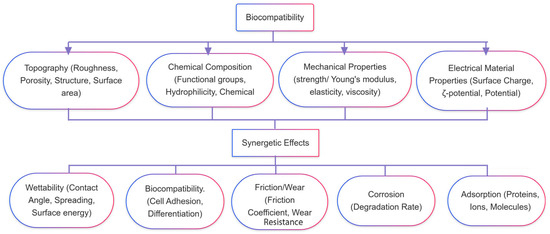
Figure 13.
Conceptual framework for synergistic effects of surface electric charge, topography, chemistry, and stiffness on cellular responses in biomaterials.
Overall, this review consolidates current knowledge on the role of surface electric properties in governing the bioactivity of implantable biomaterials. By examining both qualitative trends and quantitative data across recent studies (2015–2024), we demonstrate that the surface electric charge—particularly the sign, magnitude, and local distribution of zeta potential—is a key determinant of biocompatibility. Importantly, these effects are further modulated by factors such as surface morphology, hydrophilicity, and chemical composition. Despite the promising results, the literature reveals a lack of standardized methodologies for isolating the influence of electric charge from other surface characteristics. Future research should therefore prioritize the development of integrated analytical protocols and controlled surface engineering strategies to fully harness the potential of electroactive materials in regenerative medicine and implant technology.
Theoretical and computational modeling plays an increasingly vital role in elucidating how surface electric charge influences biological responses. While experimental studies provide valuable insight into cellular behavior, modeling approaches help disentangle the contributions of surface charge from other interdependent factors such as roughness or wettability. One common strategy is molecular dynamics (MD) simulation, which enables nanoscale analysis of electric double layer (EDL) formation and ion distribution near the surface. These simulations help understand how variations in charge density influence protein adsorption, conformational changes, and early-stage cell attachment [28,58].
Another key method is finite element modeling (FEM), which has been used to simulate potential gradients and electric field strength across complex surface geometries. Such models are useful in predicting spatial variations in charging and their corresponding biological impact [63,64]. Modeling efforts also include computational electrochemistry to calculate zeta potential distributions in multi-ion systems and simulate biological fluids’ response to charged surfaces. These tools provide predictive capabilities for optimizing biomaterial designs before costly in vitro or in vivo testing. By integrating theoretical and empirical approaches, researchers can move toward standardized, predictive frameworks for bioelectrical compatibility and surface engineering in regenerative medicine.
The interpretation of experimental data on surface charge–mediated bioactivity is fundamentally grounded in electrochemical theory. Central to this understanding is the electric double layer (EDL) model, which describes how charged material surfaces interact with ions in physiological media. According to the Stern model, a tightly bound Helmholtz layer of counterions forms near the surface, followed by a diffuse layer extending into the surrounding fluid. The zeta potential (ζ) represents the electric potential at the slipping plane of this diffuse layer and serves as a measurable proxy for surface charge in biological environments.
These theoretical constructs help explain several consistent experimental trends. For instance, negatively charged surfaces (−20 to −30 mV) attract divalent cations (Ca2+, Mg2+), facilitating apatite nucleation and enhanced osteoblast adhesion. Field effects extending up to 0.7 mm from charging hydroxyapatite surfaces align with predictions from electric field decay models and support the concept of an impact distance. Additionally, the interaction between surface charge and proteins—governed by Coulombic forces and dipole alignment—helps interpret variations in fibronectin or collagen adsorption across differently charged substrates.
Moreover, molecular dynamics (MD) simulations of charged surfaces in ionic environments and finite element models (FEM) of local field gradients offer predictive tools that match well with observed biological phenomena such as macrophage charging and selective protein adsorption. Thus, theoretical modeling not only validates empirical observations but also supports the predictive engineering of biofunctional surfaces.
Table 2 summarizes key design parameters for engineering implant surfaces with targeted biological effects. The matrix integrates evidence from multiple studies to provide practical guidance on the optimal range of surface zeta potential, topography, and wettability for promoting specific outcomes such as osteoblast adhesion, enhanced mineralization, immunomodulation, and antibacterial performance. By aligning surface charge (e.g., −20 to −30 mV) with appropriate roughness and hydrophilic properties, materials can be tailored to support bone regeneration or infection control. This decision matrix serves as a conceptual guide for surface engineers developing next-generation bioactive implants.

Table 2.
Design matrix for tailoring surface charge and topography to biological function.
To resolve persistent ambiguities and guide next-generation biomaterial design, we propose the following key research questions and experimental directions:
- What is the critical range of zeta potential for promoting osteointegration without triggering inflammation? Systematic testing using a zeta potential gradient (e.g., from −50 to +30 mV) on chemically identical surfaces could identify threshold values for osteoblast proliferation vs. macrophage activation.
- How can the effects of surface charge be decoupled from wettability and roughness? A factorial design (e.g., a 3 × 3 matrix combining ζ-potential, contact angle, and roughness) on a single base material would allow statistical isolation of individual contributions to cell behavior.
- How stable is surface charge under physiological conditions over time? Longitudinal studies measuring ζ-potential, protein adsorption, and cell response over 1 to 12 weeks (including sterilization and aging steps) would clarify how charge-related effects persist in real-world conditions.
- What is the effective spatial range of charged surfaces (“charging distance”) in tissue? In vitro or ex vivo assays with distance-mapped mineralization or ion concentration gradients could define the radius of biological influence, which has been preliminarily observed to extend up to 0.7 mm.
- Can predictive models (e.g., molecular dynamics + finite element simulations) reproduce electrostatic protein–surface interactions? Coupling simulations of electrical double layer formation with protein adsorption studies could improve understanding of early-stage biointerface dynamics and support computational material design.
These research directions aim to transition surface charge studies from largely descriptive to mechanistically predictive, enabling the development of implant surfaces with precisely tuned bioelectrical properties.
5. Conclusions
Despite the increasing number of publications addressing the biological effects of surface charge, many studies remain primarily descriptive. Most fail to isolate the specific role of electrostatic properties due to the confounding effects of surface topography, chemistry, or wettability.
Our analysis supports the conclusion that net surface electric potential is a critical determinant of biomaterial biocompatibility. Parameters such as charge sign, local charge density, and spatial uniformity significantly influence cellular responses. Numerous studies confirm that moderately negative surfaces—typically in the range of −20 to −30 mV—optimize osteoblast adhesion and proliferation due to favorable electrostatic interactions with the passive surface potential of cell membranes, which originates from the net negative charge of membrane lipids and associated proteins. In contrast, surfaces with a net positive charge show promise for antibacterial applications and immunomodulatory effects, although further optimization is required to avoid undesired pro-inflammatory responses or tissue rejection. To advance this field and improve clinical translatability, we propose the following research priorities:
Zeta potential should be measured in biologically relevant conditions (e.g., in culture media, not just in air or PBS), with clear reporting of pH, ionic strength, and instrumentation settings.
More studies are needed to pinpoint charge thresholds that reliably enhance osteogenic differentiation while minimizing inflammatory or cytotoxic responses. Current evidence supports a favorable range between −20 and −45 mV for hMSCs, but generalizability remains limited.
Future research should clarify how electrostatic cues interact with integrin clustering, focal adhesion dynamics, and cytoskeletal tension. The role of electric double layer (EDL) composition and its temporal evolution near charged biomaterial surfaces also requires deeper exploration.
Surface charge does not act alone. Studies should consider its interplay with topography, stiffness, and surface chemistry in a multivariate design framework, using both experimental and computational approaches.
By addressing these gaps, the field can progress toward predictive, tunable, and application-specific biointerfaces. This will open pathways for the development of implants and scaffolds that more effectively guide cell behavior, reduce complications, and improve long-term performance in regenerative medicine.
Funding
This study was performed according to a government research assignment for ISPMS SB. RAS, project FWRW-2021-0007.
Data Availability Statement
Not applicable.
Conflicts of Interest
The author declares no conflicts of interest.
References
- Heimann, R.B. Magnesium Alloys for Biomedical Application: Advanced Corrosion Control through Surface Coating. Surf. Coat. Technol. 2021, 405, 126521. [Google Scholar] [CrossRef]
- Sharkeev, Y.P.; Popova, K.S.; Prosolov, K.A.; Freimanis, E.; Dekhtyar, Y.; Khlusov, I.A. Electrical Potential and Topography of the Surface of a Calcium-Phosphate Coating Deposited with RF-Magnetron Discharge. J. Surf. Investig. X-Ray Synchrotron Neutron. Tech. 2020, 14, 200–206. [Google Scholar] [CrossRef]
- Chebodaeva, V.; Sedelnikova, M.; Khimich, M.; Bakina, O.; Tolmachev, A.; Miller, A.; Golohvast, K.; Zakharenko, A.; Egorkin, V.; Vyaliy, I.; et al. Antibacterial Calcium Phosphate Coatings with Zinc Oxide Nanoparticles. Coatings 2023, 13, 1921. [Google Scholar] [CrossRef]
- Metwally, S.; Ferraris, S.; Spriano, S.; Krysiak, Z.J.; Kaniuk, Ł.; Marzec, M.M.; Kim, S.K.; Szewczyk, P.K.; Gruszczyński, A.; Wytrwal-Sarna, M.; et al. Surface Potential and Roughness Controlled Cell Adhesion and Collagen Formation in Electrospun PCL Fibers for Bone Regeneration. Mater. Des. 2020, 194, 108915. [Google Scholar] [CrossRef]
- Das, A.; Dobbidi, P.; Bhardwaj, A.; Saxena, V.; Pandey, L.M. Microstructural, Electrical and Biological Activity in Ca10(PO4)6(OH)2-Ba0.5Sr0.5TiO3 Ceramic Composites Designed for Tissue Engineering Applications. Sci. Rep. 2021, 11, 22304. [Google Scholar] [CrossRef]
- Sabbah, M.; Esposito, M. Insight into Zeta Potential Measurements in Biopolymer Film Preparation. J. Biotechnol. Biomater. 2016, 6, 1000e126. [Google Scholar] [CrossRef]
- Kumar, D.; Gittings, J.P.; Turner, I.G.; Bowen, C.R.; Bastida-Hidalgo, A.; Cartmell, S.H. Polarization of Hydroxyapatite: Influence on Osteoblast Cell Proliferation. Acta Biomater. 2010, 6, 1549–1554. [Google Scholar] [CrossRef]
- Polak, M.; Berniak, K.; Szewczyk, P.K.; Knapczyk-Korczak, J.; Marzec, M.M.; Purbayanto, M.A.K.; Jastrzębska, A.M.; Stachewicz, U. Modulating Cell Adhesion and Infiltration in Advanced Scaffold Designs Based on PLLA Fibers with RGO and MXene (Ti3C2T). Mater. Today Bio 2025, 32, 101785. [Google Scholar] [CrossRef]
- Iwai, R.; Nemoto, Y.; Nakayama, Y. The Effect of Electrically Charged Polyion Complex Nanoparticle-Coated Surfaces on Adipose-Derived Stromal Progenitor Cell Behaviour. Biomaterials 2013, 34, 9096–9102. [Google Scholar] [CrossRef]
- Mao, L.; Bai, L.; Wang, X.; Chen, X.; Zhang, D.; Chen, F.; Liu, C. Enhanced Cell Osteogenesis and Osteoimmunology Regulated by Piezoelectric Biomaterials with Controllable Surface Potential and Charges. ACS Appl. Mater. Interfaces 2022, 14, 44111–44124. [Google Scholar] [CrossRef]
- Bai, Y.; Zheng, X.; Zhong, X.; Cui, Q.; Zhang, S.; Wen, X.; Heng, B.C.; He, S.; Shen, Y.; Zhang, J.; et al. Manipulation of Heterogeneous Surface Electric Potential Promotes Osteogenesis by Strengthening RGD Peptide Binding and Cellular Mechanosensing. Adv. Mater. 2023, 35, e2209769. [Google Scholar] [CrossRef] [PubMed]
- Cui, Q.; Zheng, X.; Bai, Y.; Guo, Y.; Liu, S.; Lu, Y.; Liu, L.; Song, J.; Liu, Y.; Heng, B.C.; et al. Manipulation of Surface Potential Distribution Enhances Osteogenesis by Promoting Pro-Angiogenic Macrophage Polarization via Activation of the PI3K-Akt Signaling Pathway. Adv. Sci. 2025, 12, e2414278. [Google Scholar] [CrossRef]
- Bandyopadhyay, A.; Shivaram, A.; Mitra, I.; Bose, S. Electrically Polarized TiO2 Nanotubes on Ti Implants to Enhance Early-Stage Osseointegration. Acta Biomater. 2019, 96, 686–693. [Google Scholar] [CrossRef]
- Bystrov, V.; Bystrova, A.; Dekhtyar, Y.; Khlusov, I.A.; Pichugin, V.; Prosolov, K.; Sharkeev, Y. Electrical Functionalization and Fabrication of Nanostructured Hydroxyapatite Coatings. In Bioceramics and Biocomposites; Wiley: Hoboken, NJ, USA, 2019; pp. 149–190. [Google Scholar]
- Sedelnikova, M.B.; Komarova, E.G.; Sharkeev, Y.P.; Chebodaeva, V.V.; Tolkacheva, T.V.; Kondranova, A.M.; Zakharenko, A.M.; Bakina, O.V. Effect of the Porosity, Roughness, Wettability, and Charge of Micro-Arc Coatings on the Efficiency of Doxorubicin Delivery and Suppression of Cancer Cells. Coatings 2020, 10, 664. [Google Scholar] [CrossRef]
- Khlusov, I.A.; Dekhtyar, Y.; Sharkeev, Y.P.; Pichugin, V.F.; Khlusova, M.Y.; Polyaka, N.; Tyulkin, F.; Vendinya, V.; Legostaeva, E.V.; Litvinova, L.S.; et al. Nanoscale Electrical Potential and Roughness of a Calcium Phosphate Surface Promotes the Osteogenic Phenotype of Stromal Cells. Materials 2018, 11, 978. [Google Scholar] [CrossRef]
- Bulina, N.V.; Eremina, N.V.; Mikhailenko, M.A.; Avakyan, L.A.; Paramonova, E.V.; Vinokurova, O.B.; Makarova, S.V.; Prosanov, I.Y.; Bystrov, V.S. Isomorphous Substitution of Manganese for Calcium in Synthetic Hydroxyapatite. Mater. Chem. Phys. 2025, 342, 130957. [Google Scholar] [CrossRef]
- Dorozhkin, S.V. Calcium Orthophosphates in Tissue Engineering. In Bioceramics: Status in Tissue Engineering and Regenerative Medicine (Part 1); Bentham Science Publishers: Sharjah, United Arab Emirates, 2024; pp. 150–179. [Google Scholar]
- Majhy, B.; Priyadarshini, P.; Sen, A.K. Effect of Surface Energy and Roughness on Cell Adhesion and Growth – Facile Surface Modification for Enhanced Cell Culture. RSC Adv. 2021, 11, 15467–15476. [Google Scholar] [CrossRef]
- Ranella, A.; Barberoglou, M.; Bakogianni, S.; Fotakis, C.; Stratakis, E. Tuning Cell Adhesion by Controlling the Roughness and Wettability of 3D Micro/Nano Silicon Structures. Acta Biomater. 2010, 6, 2711–2720. [Google Scholar] [CrossRef]
- Hou, Y.; Xie, W.; Yu, L.; Camacho, L.C.; Nie, C.; Zhang, M.; Haag, R.; Wei, Q. Surface Roughness Gradients Reveal Topography-Specific Mechanosensitive Responses in Human Mesenchymal Stem Cells. Small 2020, 16, e1905422. [Google Scholar] [CrossRef]
- Bergara-Muguruza, L.; Mäkelä, K.; Yrjälä, T.; Salonen, J.; Yamashita, K.; Nakamura, M. Surface Electric Fields Increase Human Osteoclast Resorption through Improved Wettability on Carbonate-Incorporated Apatite. ACS Appl. Mater. Interfaces 2021, 13, 58270–58278. [Google Scholar] [CrossRef]
- Smith, I.O.; Baumann, M.J.; McCabe, L.R. Electrostatic Interactions as a Predictor for Osteoblast Attachment to Biomaterials. J. Biomed. Mater. Res. A 2004, 70A, 436–441. [Google Scholar] [CrossRef] [PubMed]
- Tan, F.; Liu, J.; Song, K.; Liu, M.; Wang, J. Effect of Surface Charge on Osteoblastic Proliferation and Differentiation on a Poly(Ethylene Glycol)-Diacrylate Hydrogel. J. Mater. Sci. 2018, 53, 908–920. [Google Scholar] [CrossRef]
- Bodhak, S.; Bose, S.; Bandyopadhyay, A. Electrically Polarized HAp-Coated Ti: In Vitro Bone Cell–Material Interactions. Acta Biomater. 2010, 6, 641–651. [Google Scholar] [CrossRef]
- Genchi, G.G.; Ceseracciu, L.; Marino, A.; Labardi, M.; Marras, S.; Pignatelli, F.; Bruschini, L.; Mattoli, V.; Ciofani, G. P(VDF-TrFE)/BaTiO 3 Nanoparticle Composite Films Mediate Piezoelectric Stimulation and Promote Differentiation of SH-SY5Y Neuroblastoma Cells. Adv. Health Mater. 2016, 5, 1808–1820. [Google Scholar] [CrossRef]
- Qin, W.; Xing, T.; Ma, J.; Tang, B.; Chen, W. Decoration with Electronegative 2D Materials Based on Chemical Transition Layers on CFR-PEEK Implants for Promoting Osteogenesis. J. Mech. Behav. Biomed. Mater. 2024, 152, 106436. [Google Scholar] [CrossRef]
- Metwally, S.; Stachewicz, U. Surface Potential and Charges Impact on Cell Responses on Biomaterials Interfaces for Medical Applications. Mater. Sci. Eng. C 2019, 104, 109883. [Google Scholar] [CrossRef]
- Itoh, S.; Nakamura, S.; Kobayashi, T.; Shinomiya, K.; Yamashita, K.; Itoh, S. Effect of Electrical Polarization of Hydroxyapatite Ceramics on New Bone Formation. Calcif. Tissue Int. 2006, 78, 133–142. [Google Scholar] [CrossRef]
- Rafiei, M.; Eivaz Mohammadloo, H.; Khorasani, M.; Kargaran, F.; Khonakdar, H.A. Hydroxyapatite-Based Coatings on Mg and Ti-Based Implants: A Detailed Examination of Various Coating Methodologies. Heliyon 2025, 11, e41813. [Google Scholar] [CrossRef]
- Ziyati, O.; Abou-Obeida, S.; Walim, Z.; Boussiri, K. El Hydroxyapatite-Coated Titanium Dental Implants. OAlib 2025, 12, 1–23. [Google Scholar] [CrossRef]
- Kim, Y.; Bae, C.; Ryu, K.; Ko, H.; Kim, Y.K.; Hong, S.; Shin, H. Origin of Surface Potential Change during Ferroelectric Switching in Epitaxial PbTiO3 Thin Films Studied by Scanning Force Microscopy. Appl. Phys. Lett. 2009, 94, 032907. [Google Scholar] [CrossRef]
- Verma, D.; Desai, M.S.; Kulkarni, N.; Langrana, N. Characterization of Surface Charge and Mechanical Properties of Chitosan/Alginate Based Biomaterials. Mater. Sci. Eng. C 2011, 31, 1741–1747. [Google Scholar] [CrossRef]
- Li, C.; Li, Y.; Yao, T.; Zhou, L.; Xiao, C.; Wang, Z.; Zhai, J.; Xing, J.; Chen, J.; Tan, G.; et al. Wireless Electrochemotherapy by Selenium-Doped Piezoelectric Biomaterials to Enhance Cancer Cell Apoptosis. ACS Appl. Mater. Interfaces 2020, 12, 34505–34513. [Google Scholar] [CrossRef]
- Gittens, R.A.; Scheideler, L.; Rupp, F.; Hyzy, S.L.; Geis-Gerstorfer, J.; Schwartz, Z.; Boyan, B.D. A Review on the Wettability of Dental Implant Surfaces II: Biological and Clinical Aspects. Acta Biomater. 2014, 10, 2907–2918. [Google Scholar] [CrossRef]
- Yao, T.; Chen, J.; Wang, Z.; Zhai, J.; Li, Y.; Xing, J.; Hu, S.; Tan, G.; Qi, S.; Chang, Y.; et al. The Antibacterial Effect of Potassium-Sodium Niobate Ceramics Based on Controlling Piezoelectric Properties. Colloids Surf. B Biointerfaces 2019, 175, 463–468. [Google Scholar] [CrossRef]
- Ballentine Carter, H.; Coffey, D.S. Cell Surface Charge in Predicting Metastatic Potential of Aspirated Cells from the Dunning Rat Prostatic Adenocarcinoma Model. J. Urol. 1988, 140, 173–175. [Google Scholar] [CrossRef]
- Liu, H.; Shi, Y.; Zhu, Y.; Wu, P.; Deng, Z.; Dong, Q.; Wu, M.; Cai, L. Bioinspired Piezoelectric Periosteum to Augment Bone Regeneration via Synergistic Immunomodulation and Osteogenesis. ACS Appl. Mater. Interfaces 2023, 15, 12273–12293. [Google Scholar] [CrossRef]
- Li, K.; Liu, S.; Hu, T.; Razanau, I.; Wu, X.; Ao, H.; Huang, L.; Xie, Y.; Zheng, X. Optimized Nanointerface Engineering of Micro/Nanostructured Titanium Implants to Enhance Cell–Nanotopography Interactions and Osseointegration. ACS Biomater. Sci. Eng. 2020, 6, 969–983. [Google Scholar] [CrossRef]
- Finke, B.; Luethen, F.; Schroeder, K.; Mueller, P.; Bergemann, C.; Frant, M.; Ohl, A.; Nebe, B. The Effect of Positively Charged Plasma Polymerization on Initial Osteoblastic Focal Adhesion on Titanium Surfaces. Biomaterials 2007, 28, 4521–4534. [Google Scholar] [CrossRef]
- Tovani, C.B.; Faria, A.N.; Ciancaglini, P.; Ramos, A.P. Collagen-Supported CaCO3 Cylindrical Particles Enhance Ti Bioactivity. Surf. Coat. Technol. 2019, 358, 858–864. [Google Scholar] [CrossRef]
- Shah, S.; Rangaraj, N.; Singh, S.B.; Srivastava, S. Exploring the Unexplored Avenues of Surface Charge in Nano-Medicine. Colloids Interface Sci. Commun. 2021, 42, 100406. [Google Scholar] [CrossRef]
- Spriano, S.; Sarath Chandra, V.; Cochis, A.; Uberti, F.; Rimondini, L.; Bertone, E.; Vitale, A.; Scolaro, C.; Ferrari, M.; Cirisano, F.; et al. How Do Wettability, Zeta Potential and Hydroxylation Degree Affect the Biological Response of Biomaterials? Mater. Sci. Eng. C 2017, 74, 542–555. [Google Scholar] [CrossRef]
- Chen, A.; Su, J.; Li, Y.; Zhang, H.; Shi, Y.; Yan, C.; Lu, J. 3D/4D Printed Bio-Piezoelectric Smart Scaffolds for next-Generation Bone Tissue Engineering. Int. J. Extrem. Manuf. 2023, 5, 032007. [Google Scholar] [CrossRef]
- Luo, J.; Zhao, S.; Gao, X.; Varma, S.N.; Xu, W.; Tamaddon, M.; Thorogate, R.; Yu, H.; Lu, X.; Salmeron-Sanchez, M.; et al. TiO2 Nanotopography-Driven Osteoblast Adhesion through Coulomb’s Force Evolution. ACS Appl. Mater. Interfaces 2022, 14, 34400–34414. [Google Scholar] [CrossRef]
- López-Pérez, P.M.; da Silva, R.M.P.; Serra, C.; Pashkuleva, I.; Reis, R.L. Surface Phosphorylation of Chitosan Significantly Improves Osteoblastcell Viability, Attachment and Proliferation. J. Mater. Chem. 2010, 20, 483–491. [Google Scholar] [CrossRef]
- Dias Corpa Tardelli, J.; Cândido dos Reis, A. Influence of Surface Electric Charge of Ti Implants on Osteoblastic Interaction: A Systematic Review. Saudi Dent. J. 2022, 34, 335–345. [Google Scholar] [CrossRef]
- Rajabi, A.H.; Jaffe, M.; Arinzeh, T.L. Piezoelectric Materials for Tissue Regeneration: A Review. Acta Biomater. 2015, 24, 12–23. [Google Scholar] [CrossRef]
- Lewis, R.; Asplin, K.E.; Bruce, G.; Dart, C.; Mobasheri, A.; Barrett-Jolley, R. The Role of the Membrane Potential in Chondrocyte Volume Regulation. J. Cell Physiol. 2011, 226, 2979–2986. [Google Scholar] [CrossRef]
- Zhang, Y.; Yang, M.; Park, J.; Singelyn, J.; Ma, H.; Sailor, M.J.; Ruoslahti, E.; Ozkan, M.; Ozkan, C. A Surface-Charge Study on Cellular-Uptake Behavior of F3-Peptide-Conjugated Iron Oxide Nanoparticles. Small 2009, 5, 1990–1996. [Google Scholar] [CrossRef]
- Demaine, C.; Howe, A. Cellular Physiology of Nerve and Muscle. Cell Biochem. Funct. 1987, 5, 77. [Google Scholar] [CrossRef]
- Pinese, C.; Jebors, S.; Stoebner, P.E.; Humblot, V.; Verdié, P.; Causse, L.; Garric, X.; Taillades, H.; Martinez, J.; Mehdi, A.; et al. Bioactive Peptides Grafted Silicone Dressings: A Simple and Specific Method. Mater. Today Chem. 2017, 4, 73–83. [Google Scholar] [CrossRef]
- Li, Y.; Yang, H.Y.; Thambi, T.; Park, J.-H.; Lee, D.S. Charge-Convertible Polymers for Improved Tumor Targeting and Enhanced Therapy. Biomaterials 2019, 217, 119299. [Google Scholar] [CrossRef]
- Horiuchi, N.; Nakaguki, S.; Wada, N.; Nozaki, K.; Nakamura, M.; Nagai, A.; Katayama, K.; Yamashita, K. Polarization-Induced Surface Charges in Hydroxyapatite Ceramics. J. Appl. Phys. 2014, 116, 014902. [Google Scholar] [CrossRef]
- Williams, D.F. Biocompatibility Pathways and Mechanisms for Bioactive Materials: The Bioactivity Zone. Bioact. Mater. 2022, 10, 306–322. [Google Scholar] [CrossRef]
- McCormick, D.A. Membrane Potential and Action Potential. In Fundamental Neuroscience; Elsevier: Amsterdam, The Netherlands, 2013; pp. 93–116. [Google Scholar]
- Goodman, S. Cell Membranes. In Medical Cell Biology; Elsevier: Amsterdam, The Netherlands, 2008; pp. 27–57. [Google Scholar]
- Groß, A.; Sakong, S. Modelling the Electric Double Layer at Electrode/Electrolyte Interfaces. Curr. Opin. Electrochem. 2019, 14, 1–6. [Google Scholar] [CrossRef]
- Dukhin, A.S.; Xu, R. Biological and Biomedical Applications. Interface Sci. Technol. 2025, 39, 321–339. [Google Scholar]
- Carroll, R.G. Cellular Function. In Elsevier’s Integrated Physiology; Elsevier: Amsterdam, The Netherlands, 2007; pp. 27–42. [Google Scholar]
- Kwon, H.J.; Yasuda, K.; Ohmiya, Y.; Honma, K.; Chen, Y.M.; Gong, J.P. In Vitro Differentiation of Chondrogenic ATDC5 Cells Is Enhanced by Culturing on Synthetic Hydrogels with Various Charge Densities. Acta Biomater. 2010, 6, 494–501. [Google Scholar] [CrossRef]
- Itoh, S.; Nakamura, S.; Nakamura, M.; Shinomiya, K.; Yamashita, K. Enhanced Bone Regeneration by Electrical Polarization of Hydroxyapatite. Artif. Organs 2006, 30, 863–869. [Google Scholar] [CrossRef]
- Baltacis, K.; Bystrov, V.; Bystrova, A.; Dekhtyar, Y.; Freivalds, T.; Raines, J.; Rozenberga, K.; Sorokins, H.; Zeidaks, M. Physical Fundamentals of Biomaterials Surface Electrical Functionalization. Materials 2020, 13, 4575. [Google Scholar] [CrossRef]
- Tofail, S.A.M.; Gandhi, A.A. Electrical Modifications of Biomaterials’ Surfaces: Beyond Hydrophobicity and Hydrophilicity. In Biological Interactions with Surface Charge in Biomaterials; The Royal Society of Chemistry: London, UK, 2011; pp. 3–14. [Google Scholar]
Disclaimer/Publisher’s Note: The statements, opinions and data contained in all publications are solely those of the individual author(s) and contributor(s) and not of MDPI and/or the editor(s). MDPI and/or the editor(s) disclaim responsibility for any injury to people or property resulting from any ideas, methods, instructions or products referred to in the content. |
© 2025 by the author. Licensee MDPI, Basel, Switzerland. This article is an open access article distributed under the terms and conditions of the Creative Commons Attribution (CC BY) license (https://creativecommons.org/licenses/by/4.0/).